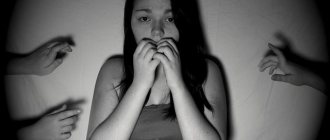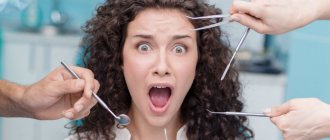Erythrophobia is the fear of blushing in the presence of other people. According to statistics, 0.2% of people are affected by this disorder. Most often, women suffer from erythrophobia due to their inherent emotionality, but men are also familiar with this psychological disorder.
This unpleasant condition can cause a person a lot of trouble when communicating closely with other people, and prevents him from easily establishing social contacts, speaking in public, and performing professional duties if his profession involves working with people. Redness of the face due to anxiety is also called blushing syndrome. If it is accompanied by fear that others will notice the reddened face, then this is the condition that becomes the basis of erythrophobia.
Externally, the fear of blushing manifests itself in a change in the color of the entire surface of the face or the appearance of red spots on it. The ears, neck and part of the chest may also turn red. Redness of the skin of these parts of the body occurs instantly; a person cannot control it.
Such a physiological reaction as redness of the face is also characteristic of completely healthy people. The face may turn red due to physical stress, eating too spicy or hot food, stress, fear, embarrassment, shame, or severe nervous experience. But, unlike erythrophobia, it is not accompanied by feelings of anxiety and fear.
For erythrophobes, all these completely normal physiological manifestations cause severe discomfort and tension, a feeling of awkwardness. The unpleasant sensations that arise from this are so strong that they make people afraid of the very possibility of blushing.
The fear of blushing greatly bothers all people, but most of all it affects public people and those who, because of their profession, must maintain a lot of social contacts. The chronic fear that accompanies such people quickly turns into chronic stress, leading to indecision, self-doubt and isolation. Therefore, many erythrophobes, in order to avoid the possibility of finding themselves in a situation where they might blush, even refuse profitable and promising work if it involves communicating with people. They also generally try to reduce contacts with strangers to a minimum, do not make friends and do not build close relationships with the opposite sex. Emptiness and loneliness lead to the development of depression, neuroses, and suicidal thoughts in some erythrophobes.
Erythrophobia creates many obstacles to a normal, active and eventful and social life, and therefore requires treatment. Since this is mainly a psychological problem, it can most easily be eliminated using psychotherapy methods.
Reasons for development
Overly shy people can often “blush”
In general, embarrassment and a blush on the cheeks do not cause rejection or ridicule among others, but people with erythrophobia do not think so. The tendency to flush the face in a stressful situation is due to physiological characteristics, namely the superficial location of the capillaries. At times of stress, blood literally rushes to the cheeks, and since the capillaries are located shallow under the skin, the redness of the face is noticeable to others. This is also accompanied by a feeling of heat in the face, so a person with this feature knows exactly when he starts to blush.
Despite the fact that the mechanism of facial redness during stress has been well studied, the causes of erythrophobia remain a mystery to psychologists and psychiatrists. This phobia has no clearly defined cause and is most likely caused by subjective feelings that arise during moments of stress or shame.
Many people associate erythrophobia with:
- features of the functioning of the nervous system;
- specifics of education;
- hidden complexes;
- features of behavior.
In general, the mechanism of facial redness is explained by the specifics of the nervous system, or more precisely, its autonomic department. For some reason, in moments of stress, it signals the blood vessels and capillaries to dilate. They fill with blood, a feeling of heat occurs, and the skin turns red. In people with closely spaced capillaries and thin skin, this is explained by physiological characteristics, but also in people with normal skin thickness, this phenomenon often occurs. However, the ability to blush in awkward situations does not mean the presence of erythrophobia. Some psychiatrists and psychotherapists believe that the appearance of a feeling of fear in response to a reaction from one’s own skin is explained by a surge in norepinephrine at times of stress. Thus, only people who do not know how to independently cope with the destructive influence of stress encounter a phobia, which means their nervous system is constantly under tension.
Another suspected reason for the appearance of a phobia is a peculiarity of upbringing. All children tend to play pranks and disobey their parents, but shy and modest children often take comments too seriously. For example, a child may do something bad, but does not admit it to his parents. Adults can easily guess about his offense, noticing that the blood rushes to the face and the baby experiences severe embarrassment and shame. If at this moment the parents put too much emphasis on the educational process (scold, punish the baby), an incorrect subconscious attitude may be formed that associates the process of blushing with the fear of punishment.
Erythrophobia may be a consequence of an inferiority complex and pathological feelings of guilt. A person constantly feels guilty for any of his actions and subconsciously expects criticism and punishment, while reddening of the skin of the face is taken as an admission of his misdeeds, thereby beginning to be afraid of this natural phenomenon.
Another reason may be a person’s hidden motives when committing an act. In this case, we are talking more about false erythrophobia, since the person does not experience fear of redness of the face, but fear of being discovered.
What kind of disease is this
Fear of blushing is often confused with blushing syndrome. In contrast, erythrophobia is accompanied by fear.
It is
a reaction of the nervous system to stimuli.
A person can no longer independently control the processes in the body. He is afraid of making a bad impression on his interlocutor and is convinced that a red face repels others. The fear of turning purple in the presence of people is psychological in nature.
There are two types of erythrophobia:
1. Classic . The whole face turns red. 2. Geographical . Certain areas turn purple.
This phobia gives rise to self-doubt, and, as a result, a person experiences neuroses and stress, and tries to avoid crowds of people.
There are other unpleasant consequences of this pathology:
• lack of desire to move forward; • complete withdrawal from interaction with society; • development of depression; • fear of expressing one's opinion; • constant dissatisfaction with oneself.
In rare cases, the patient experiences a feeling of hopelessness and begins to think about suicide.
Symptoms of erythrophobia
Increased heart rate appears
A symptom of erythrophobia is facial flushing in response to any psycho-emotional experiences, even minor ones. A person feels a rush of blood to the face and begins to experience anxiety and restlessness, as the redness is noticeable to others. Over time, these emotions deplete the nervous system, and a person begins to experience fear even in a calm state, constantly waiting for something to throw him off balance and red spots to appear on his face.
Anxiety and fear are associated not so much with the fact of redness of the skin, but with the emotions that precede this moment.
Some patients describe their experience as a constant agonizing wait for the moment the face turns red, that is, fear appears long before this happens.
In severe forms of erythrophobia, during a rush of blood to the skin of the face, a person faces a real panic attack. Its symptoms:
- growing anxiety;
- feeling of panic and uncontrollable fear;
- trembling hands;
- flushed face;
- chills and cold sweat;
- lack of air and shortness of breath;
- tachycardia;
- headache and dizziness;
- feeling of derealization.
It is interesting that a panic attack occurs in response to a feeling of fear at the moment of redness of the face, but at the same time it provokes dilation of the skin capillaries and a rush of blood, as it is accompanied by hyperactivity of the autonomic nervous system. In other words, a panic attack with erythrophobia makes the object of fear even more pronounced. In some cases, a person may experience such internal tension at this moment that the central nervous system simply cannot stand it, so a panic attack ends in a short-term fainting.
Operating on blush
I probably would have come to terms with my misfortune if it weren’t for meeting Karl. A young historian came to Russia from Munich and collected materials from our archives for his book about the Second World War. I helped him find the necessary documents. Suddenly, working together became friendship, and then turned into more serious feelings. Now I understand that my courage in this relationship at that time was explained by the use of strong drugs. Inspired, literally pumped up with pills, I went to visit Karl in Germany.
And then I noticed that my recent salvation—medicines—was no longer working. A completely unfamiliar environment, the need to communicate in a foreign language with Karl’s friends and relatives... Every look made me blush.
At first Karl laughed it off: I have such a ruddy Russian girl, very shy... And then my endless panic attacks began to irritate him too. Soon I bought a return ticket to Moscow. Literally on the day of departure, Karl’s father (he practiced as a homeopath in one of the Munich clinics) called me aside and said that in Germany there is a doctor, Christoph Schick, who ... operates on my illness.
To be honest, at first I thought that I had translated it incorrectly from German. How can you treat blush? Having returned to Moscow, I surfed the Internet and discovered that blushing has indeed recently been treated with surgery. There are also surgeons in Russia who have mastered this technique.
VC.:
Nina tried all treatment options and was so disappointed that her only option was surgery. Indeed, it sounds strange: treating blush with surgery. During this procedure, the surgeon performs a sympathectomy - blocks the so-called sympathetic ganglia. As a result, the sympathetic influence on the vessels of the face, neck and décolleté stops. And now, when experiencing stress, the patient does not blush. But surgery is not suitable for everyone, which is why it is so important to recommend it only to those who really need it. My practice shows that the best candidates for sympathectomy are people with a pale complexion who instantly blush due to any nervous tension (and just as quickly the color disappears from their face). For those whose blush lasts for several hours, surgery will not help. And the surgeon will not offer help when a person has areas of skin on his face with persistent redness.
How to treat erythrophobia?
For erythrophobia, treatment begins with a consultation with a general practitioner (therapist). The fact is that a rush of blood to the skin of the face can be a consequence of an overactive thyroid gland or high blood pressure, so you must first undergo a comprehensive examination to rule out organic causes of the phobia.
Then the patient needs to consult with a psychotherapist. The doctor will select the optimal treatment regimen based on the causes of erythrophobia and the severity of symptoms.
Psychotherapy
The task of the psychotherapist is to explain to the patient that redness of the facial skin in itself in response to strong emotions is not a pathology and is not dangerous to health. As a rule, cognitive-behavioral therapy is practiced, during which the patient must change his attitude towards blushing syndrome (this is the name for the phenomenon of stress-induced redness of the face).
An important part of therapy is restoring the patient’s adequate self-esteem and getting rid of feelings of guilt.
As a rule, hypnosis or Gestalt therapy for erythrophobia are ineffective and therefore are not used. During cognitive behavioral psychotherapy, it is possible to reduce the depth of the patient’s feelings due to facial redness, but a long course of treatment is required to completely get rid of the problem.
Medicines
The drug is specially designed to suppress panic attacks
On how to treat erythrophobia, you need to consult with several specialists at once. Those who have successfully gotten rid of erythrophobia claim that drug therapy played a major role in the treatment process. The drugs are usually prescribed by a therapist, neurologist or psychiatrist (psychotherapist). Preference is given to drugs to reduce the effects of stress - Tenoten, Notta drops, Sedistress tablets and other sedative drugs.
For frequent attacks of anxiety, tranquilizers (Adaptol, Afobazol) or potent herbal medicines (Novo-passit) are recommended.
Additionally, simple nootropic drugs, for example, Glycine tablets, can be prescribed.
The goal of drug therapy is to reduce nervous excitability and reduce the activity of the sympathetic nervous system. It is part of the autonomic nervous system and is responsible for vasodilation and blood flow to the facial skin. As practice shows, a short course of drug therapy makes the patient more receptive to psychotherapy and home treatment. However, the drugs should not be abused, since potent anxiolytics (tranquilizers) are addictive, and “safe” sedatives, when taken for a long time, disrupt the functioning of the cardiovascular system.
Surgical intervention
The fastest and most effective method of treatment is sympathectomy for erythrophobia. This is a fairly simple operation for erythrophobia, which consists of resection of the sympathetic nerve trunk of the chest, responsible for the blood circulation of the face. In other words, during the procedure, part of the nerve fibers is pinched, due to the activity of which there is a rush of blood to the cheeks in response to stressful situations. The whole procedure takes no more than 40 minutes. The operation is safe, and rehabilitation lasts no more than a week.
Despite the fact that sympathectomy really helps with erythrophobia, it is not a panacea. The fact is that the mechanism of development of phobia is determined by the peculiarity of the patient’s mental state. It is not enough to remove the cause of fear; it is also necessary to normalize the functioning of the psyche, therefore, after sympathectomy, the patient is recommended to undergo a course of cognitive behavioral therapy.
Treatment at home
Among the non-traditional means, the following methods can be distinguished:
1. Mint decoction. You need to chop 1 tablespoon of mint leaves and pour a glass of boiling water over it. The resulting composition is kept in a water bath for 15 minutes, and then cooled and drunk half a glass in the morning and evening. 2. Hardening. It is necessary to douse yourself with cool water every morning, gradually lowering its temperature. In the evening a contrast shower is shown. 3. Yoga, breathing exercises. These methods will increase self-confidence and reduce unwanted heartbeat.
It is necessary to exclude massage, hot baths and compresses.
Fear of blushing leads to a deterioration in the quality of life and the development of depression. Therefore, it is necessary to treat it completely using modern methods of therapy. It is worth contacting a psychotherapist who will help you find the essence of the problem and relieve unpleasant symptoms.
Traditional medicine recipes
Any treatment for facial redness in a folk recipe comes down to the use of external remedies in the form of compresses or lotions, as well as rubbing and taking soothing tinctures:
- You need to take 2 dessert spoons of burnet root, pour a glass of boiling water over them and leave for about half an hour. Use as a means for warm compresses, each of which should be kept on the face for no more than an hour.
- Grind oak bark, take one spoon of raw material and add it to 500 ml of water. Boil everything together for 10 minutes over moderate heat and then apply as compresses.
- Oak bark can be replaced with freshly brewed and strong infusion of high-quality black tea.
- In the morning, you need to completely wipe your body with cool water with the addition of table salt. For 1 liter of water – 1 teaspoon of crystals.
- You should regularly take a contrast shower, which will allow the skin to adapt to temperature changes and stop reacting with redness to changing climatic conditions.
- A decoction made from the green parts of peppermint is used to rinse the body before going to bed. 1 dessert spoon of fresh mint leaves is brewed with a glass of boiling water, infused for 15 minutes and the entire volume is diluted in 5 liters of warm water prepared for washing.
- It is recommended to drink mint tea as a natural sedative: half a cup twice a day.
Pale look
But I returned from the meeting with the Moscow doctor discouraged: for half an hour the doctor... tried to dissuade me from the operation. I was frightened by the side effects. These warnings probably stopped someone, but not the girl in love! The very next morning I woke up with a firmly made decision and went to the surgeon again... The operation lasted half an hour, I felt the results immediately. As the classics wrote: “Her cheeks remained as cold as ice...” A day later I was discharged from the clinic. The puncture sites only hurt a little. The doctor warned: try not to gain weight, don’t go to the bathhouse, don’t sunbathe in the solarium, refrain from traveling to resorts with a hot climate... Germany is not the warmest country - I flew to see Karl a week later. Probably no one has ever been as happy about his pale appearance as I am!
I also made a vow to myself. When I have a child, I will try to send him to a school where teachers will worry about how not to hurt the child with a careless word, not to cause him spiritual wound.
VC.:
How is the operation done? The surgeon only needs half a centimeter punctures to get close to the sympathetic ganglia. The surgical technique would be used more often, but this method of treating erythrophobia has side effects. The nerve that surgeons compress is responsible not only for the blood vessels on the face, but also controls sweating. Therefore, in some cases, a person’s chest, back, stomach, and sometimes hips and buttocks begin to sweat a lot. This problem is called compensatory hyperhidrosis. Nina was lucky: she did not experience this complication.
Tags: erythrophobia, erythrophobia treatment, erythrophobia surgery, medications for erythrophobia, blushing, blushing syndrome 07/30/2017| Rating (3.48)
Author:
Nina Shchipacheva. Photo: Legion Media
Anastasia Myskina: “Beauty is in constancy”
Abdominoplasty: the most popular plastic surgery in the world
Slippery business: what are the benefits of fats for the body?
Expert advice: 6 important features of a post-New Year detox
Back
Comments
Please enable JavaScript to view the comments powered by Disqus. KIZ recommends
How not to wash your face: 5 most common mistakes
Lena Lenina - about how to get rid of gigolo with the help of jokes about blondes
How beauty standards changed in the 20th century
Nicole Kidman: how the style of the red-haired beauty from Honolulu has changed
7 trendy swimsuits for summer – 2019
Photos are enough: top 5 gifts that it’s time to stop bringing from trips
Loading… Competitions
Participate and win!
Horoscopes
The danger of phobia and its consequences
Fear of blushing reduces the patient's quality of life. It is difficult for him to interact with people, make contacts, and communicate. Some people choose solitude, isolation. Others have to give up a profession that is interesting and for which they have the ability. This category includes all types of activities related to publicity and speaking in front of an audience.
It is important! Against the background of erythrophobia, social phobia, depression, alcohol and drug addiction develop. Each relapse of depression becomes more complex and protracted, and this can lead to suicide.
Methods that help get rid of blushing
- The first way is to relax the facial muscles. As soon as you feel that the tide is coming, try to relax the muscles of your neck and shoulders. A smile is the best way to hide your shortcomings. When smiling, almost all people's cheeks turn red.
- Blink and take a couple of deep breaths, focusing on your breathing. Practice this method at home, then it will become easier for you to say no to phobias and fears in public. Accept yourself as you are. Keep a cool mind in any situation.
- Do not wear clothes that restrict movement or cause excessive sweating.
- Expand your horizons and vocabulary, try to be less nervous. Many of us are afraid of blushing when we have nothing to say in response to our interlocutor. During stress during a conversation, many people begin to forget the right words, and then awkwardness arises.
Work on yourself
There are many psychological trainings that help increase self-esteem. In the presence of erythrophobia, the person who blushes is afraid of being ridiculed by others. Remember that it is not your fault, it is your physiological feature.
Learn not to look away and try to keep your interlocutor at a comfortable distance. Take control of the situation. If you can’t work on your self-esteem on your own, use the help of a psychologist. You need to realize why a wave of embarrassment comes over you during a conversation. Understand your deepest fears and worries.
Sedatives from the pharmacy
Don't worry too much about what others might think of you.
Diagnostics
The diagnosis is made by a psychologist or psychotherapist based on complaints and examination results. Erythrophobia in blushing syndrome is differentiated from facial redness during menopause, the initial stage of rosacea, carcinoid syndrome and facial hyperemia when taking certain medications. To exclude the listed diseases and conditions, patients suffering from erythrophobia are referred for consultation to a gynecologist, endocrinologist, oncologist and dermatologist. The list of additional studies for erythrophobia is determined individually depending on the existing symptoms.
Operation
Treatment of erythrophobia involves surgery.
During the operation, the operation of the nodes of one of the parts of the autonomic nervous system is affected. It's called sympathectomy .
It is used in case of lack of effect from psychotherapy and medications. For geographic erythrophobia, this method is not recommended.
There are other contraindications:
• serious damage to the heart and blood vessels; • severe sclerosis of cerebral vessels; • some infections.
Surgery is performed under general anesthesia.
It has side effects:
• hypotension; • increased sweating; • reduced reaction to stress.
Reviews about the operation are predominantly positive. Many people have already eliminated unpleasant symptoms. Sympathectomy gives good clinical results and often relieves the patient of problems forever.
Patients note that it is important to choose a professional clinic for the operation and make sure that the doctors are experienced. Sympathectomy is often performed for reasons other than indications. Doctors do not always inform patients about possible conservative treatment methods, as well as what side effects the patient can expect after surgery. It is necessary to ensure that the medical facility is sufficiently equipped with the necessary equipment.
The inexperience of a specialist can lead to a technically incorrect operation. There is a possibility of damage to the accessory nerves, which leads to negative consequences.











